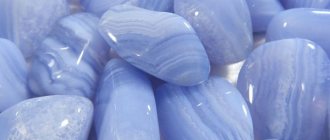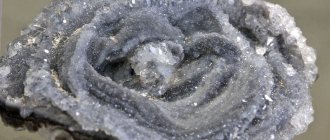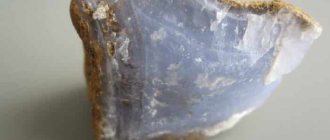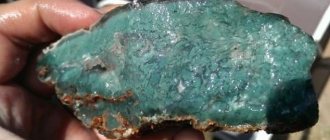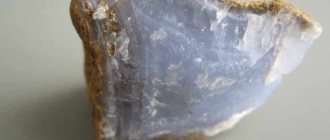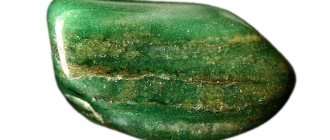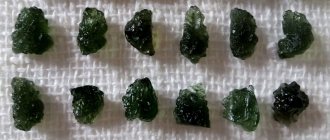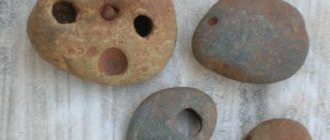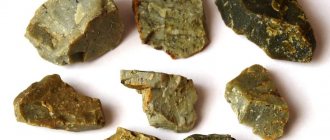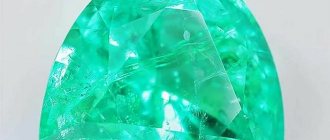Chalcedony is a semi-precious mineral, which, thanks to its wide range of shades, is very popular in the manufacture of jewelry and costume jewelry.
A ring or earrings with chalcedony will not only complement your look - they can become a real talisman for their owner , whose magical properties will ward off blues and depression.
History and origin
In ancient times, the skill of stone processing was highly developed. In Ancient Greece, gems were valued, imported for a long time, for the sake of whose possession wars were started. On the coast of the Sea of Marmara in the ancient Greek city of Chalcedon in Asia Minor (now part of modern Turkey), a deposit of quartz chalcedony, a wonderful stone distinguished by its richness of colors, was discovered.
The stone was named after the city where it was found.
Jewelry craftsmen made gems from chalcedony: cameos, seals, relief images on cabochons, where multi-layering and shades of the color of the stone were used.
Chalcedony stone
Glyptics is the art of carving miniature relief images on colored stones and gems: carnelian, agate, sapphirine. Stones processed in this way, with figures of people, birds and animals, allegorical images of military, religious and everyday scenes, were called gems. The image in a convex technique is a cameo, and a recessed one is an intaglio (seal).
Thanks to the color richness of chalcedony, master carvers created wonderful effects, enhancing them through inclusions and shades, tone transitions and color play.
The city of Chalcedon was destroyed by barbarians, and with the fall of the Ancient World, interest in the stone disappeared, returning to the era of classicism. Found during excavations in Roman cities, ancient gems were of historical value and works of jewelry art. High-ranking persons could allow themselves to be decorated by inserting them into a brooch, tiara or necklace.
Interest in objects of art from the ancient world did not fade away during the Empire period; European royalty had collections of glyptic works. The Hermitage collection contained thousands of cameos made by carvers of that time and from antiquity.
It is known that Napoleon had a chalcedony ring, like Byron, and Pushkin had two such rings.
Voloshin, at his dacha in the Crimea, loved to collect colorful pebbles on the sea coast; numerous guests of the Koktebel house took them away: Marina Tsvetaeva, Osip Mandelstam, Alexander Green, Andrei Bely, Alexey Tolstoy, Nikolai Gumilyov.
Physicochemical characteristics
Chalcedony is a type of quartz - SiO2, close to it in its physical and chemical properties.
| Formula | SiO2 |
| Color | Blue, yellow, gray |
| Shine | Waxy, matte |
| Transparency | Cloudy, translucent |
| Hardness | 6,5—7 |
| Cleavage | Absent |
| Kink | Uneven, less often shelled |
| Density | 2.58—2.64 g/cm³ |
Place of extraction
Quartz is a rock-forming mineral, one of the most common in the earth’s crust; in its free form its mass fraction is 12%, in other rocks it is 60%. Chalcedony, its fine-fibered cryptocrystalline variety, is a white-yellow transparent mineral.
Chalcedony
It is formed by crystallization from volcanic rocks at temperatures of 700–1000°C or under hydrothermal influences - water and high pressures.
Due to impurities and complex geological processes in the earth's crust, chalcedony can look different, but have the same physical and chemical characteristics.
The mineral can form spherulites and spherulitic crusts with a kidney-shaped surface, continuous massifs, veins and pseudostalactites. Due to its wide distribution, it is mined all over the world. The division according to the description of chalcedony is arbitrary, and varieties of this mineral can be found even on one stone: sarder with a transition to carnelian. They can coexist in the same mine, but mainly one type of chalcedony predominates in production.
Rich deposits: in Brazil, India, USA, Uruguay, Scotland, Germany, Australia. In Russia: Transcaucasia, Chukotka, Kolyma, Primorsky Territory, Crimea (Kara-Dag), Ural. A variety of chalcedony, sapphirine, can be found on the banks and valleys of the Lena and Yenisei rivers, on the Black Sea coast, as a secondary deposit.
Place of Birth
Chalcedony is a type of quartz, which, in turn, is one of the most common minerals. Chalcedony is formed due to the crystallization process of volcanic rocks at temperatures from 700 to 1000 ° C or through hydrothermal action.
Germany is famous for its oldest deposit. In addition to this country, the mineral is mined in the following territories:
- Russia (Primorye, Eastern Siberia, Moscow region).
- Brazil.
- Islands of Madagascar.
- India.
- Australia.
- USA.
- Uruguay.
- Italy.
- Czech Republic.
- Poland.
- Scotland.
There are also mining sites in Ukraine and Transcaucasia.
Varieties and colors
Varieties of chalcedony have a bright individuality: color, properties, meaning and their own characteristics.
- Carnelian is a name of ancient Greek origin. The Latin name "carnelian", which means "dogwood berry", appeared due to its reddish color: red-brown, red-pink, yellow-red. The hue was formed due to hematite - red iron ore, sprayed with small particles. After exposure to sunlight, the density of the color of the stone changes - from shades of brown to orange. The stone is relatively inexpensive and available.
Cornelian - A variety of carnelian - sardonyx orange-red, black-red, white-brown, is highly valued and traditionally used in jewelry in carved items (eliminates fear of the future, calms). In ancient Egypt, this trefoil-shaped stone was considered a symbol of the mother goddess Isis. The carnelian amulet helped stop bleeding and protected against anger.
Carnelian stones - Sarder is reddish-brown, brown with red tints. It differs from carnelian only in shade. Pliny (1st century BC) described the technology for producing sard (an outdated term) from light chalcedony by annealing or boiling in a honey solution.
Sarder - Onyx is a ribbon chalcedony, a mineral with pronounced layering: red-brown, white with brown, black and red stripes, white with pink and yellow. There are small deposits in Chukotka, Kolyma and the Primorsky Territory on the Arabian Peninsula, India, Brazil, Uruguay, the USA, and in Russia.
Onyx - Chrysoprase is a variety of chalcedony highly valued for its color, unlike other chalcedony which is valued for its pattern or design. Nickel gave this stone a greenish or bluish-green color (usually the mineral is green due to chromium). Chrysoprase is highly valued by jewelers; depending on its characteristics, three varieties are distinguished:
- Emerald green - a rich, bright color with transparency of the stone up to 5 cm thick, homogeneous, small impurities are allowed - the highest grade.
- Emerald green chrysoprase
- Apple green, first grade, stone transparency up to 2 cm, with small opaque areas;
- Apple green chrysoprase
- Pale-colored - green-blue, yellow-green with impurities: spots, oxides and dendrites, areas with varying degrees of transparency are possible. The third grade is an ornamental stone.
- Pale colored chrysopras
Mining and processing of chrysoprase began only in the 16th century; the stone is very rare.
- Sapphirine is a bluish chalcedony of delicate shades obtained thanks to zircon (presumably). May turn pale when heated - fade.
Sapphirine - Heliotrope (bloodstone, bloody jasper) - dark green with bright red spots and stripes, looks exotic. Sometimes this variety of heliotrope is called plasma and has yellow spots. Pliny mentioned it in his works, calling it “turning with the Sun.” The mineral is valued by jewelers and collectors. The stones are used in men's rings and in the manufacture of cameos. In the Middle Ages, red splashes were given religious significance, associating them with the blood of Christ. Heliotrope was used in the manufacture of church utensils.
Heliotrope - Agate - consists of layers of different colors (the whole palette), transparency and density. Jewelers also call agate minerals that do not have a layered structure, but have a specific pattern: mossy and star-shaped. According to ancient legend, agate is the eye of a white eagle that fell to the ground after a battle with the Black Sorcerer. It is also called the Eye of the Creator, which looks at us, separating good and evil deeds.
Agate
The layering of agate gives diverse types:- Bastion - the structure of cracks and layers gives the effect of depicting a bastion - a city landscape.
Brazilian - the thinnest layers, up to 1.5 microns.
- Black, called magical.
- Mokhovaya - crystalline pattern creates branching contours.
- Star-shaped.
- Woody.
- Disk.
- Iridescent chalcedony has an optical shine effect - a blue-yellow-green iridescent metallic glow. Used for jewelry and decorative purposes.
There are a lot of us!
Chalcedony is a group of minerals, a variety of translucent quartz.
Chalcedony itself is bluish, gray-blue or gray-white translucent. Occasionally it can be almost transparent.
Just the name for a group of gems bothers buyers. Therefore, the different colors of this multifaceted stone are designated by “personal names.”
Biruni wrote about the “Mocha stone” - green chalcedony, colored with inclusions of worm-shaped or scaly chlorite crystals.
There are more than a hundred varieties of gems. Here are some of them:
- Gray glass head ( chalcedonolite ).
- Onyx is chalcedony with a distinct layered structure.
- Carnelian is an orange-red chalcedony.
- Chrysoprase . Color ranges from apple green to emerald green.
- Plasma . Onion green to dark green variety. Often there are white and yellowish spots on the body of the stone.
- Agate is a striped chalcedony, a layered stone with a whimsical arrangement of layers. Mineralogists consider chalcedony to be the mother of all agates. And there are many varieties of agate.
- Toad stone is chalcedony with a pimpled surface resembling toad skin.
- Abacus is the name given to chalcedony in the form of flattened nodules in Japan.
- Engidros (water stone, water agate) is an agate amygdala or a one-color chalcedony nodule, partially filled with water.
Expert opinion
Semenishcheva Polina
Specialist in mineralogy. Graduated from St. Petersburg Mining University.
Interesting : even silicon can be considered a type of chalcedony.
Am I an agate?
Varieties of chalcedony were previously called agates
